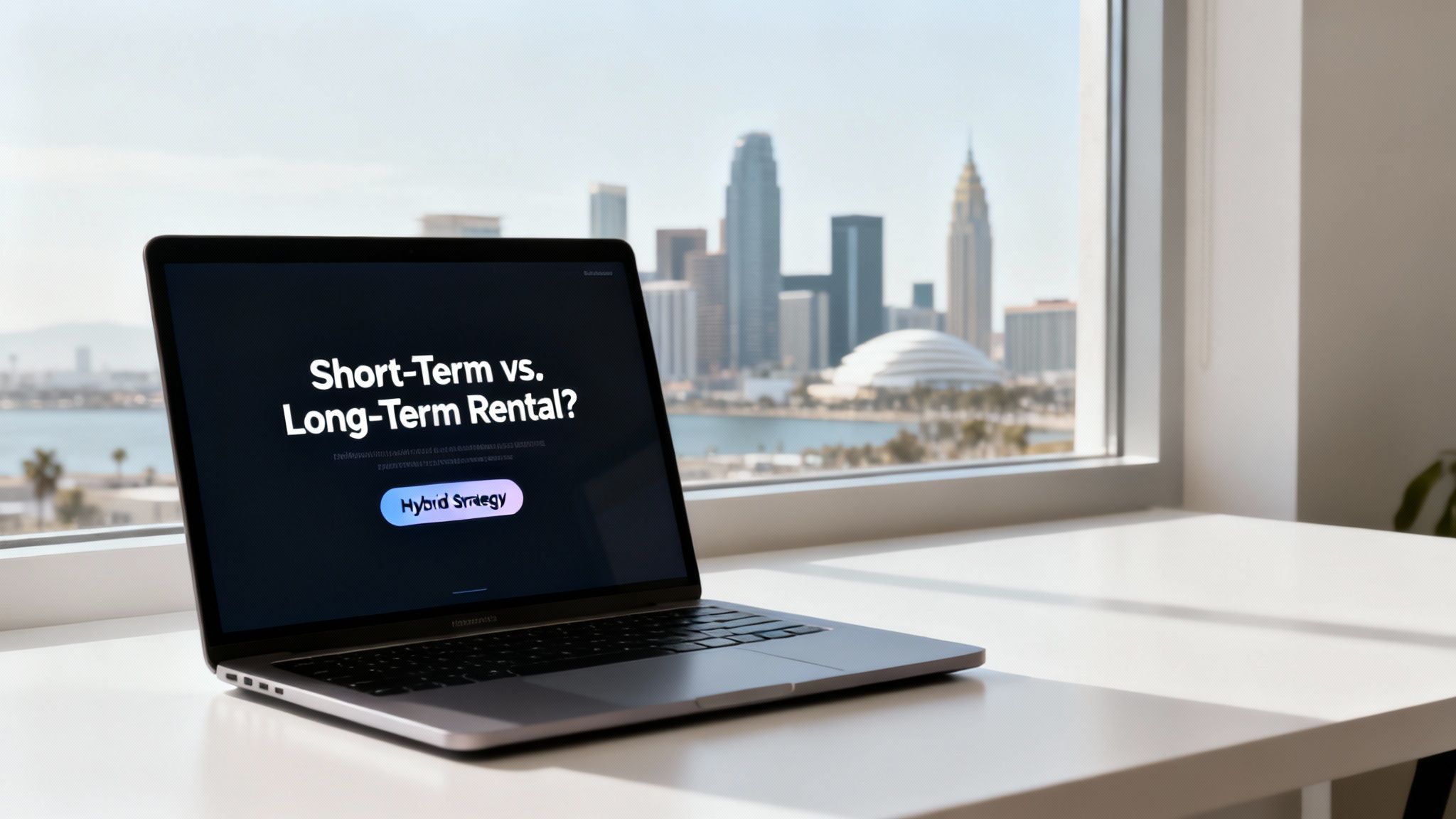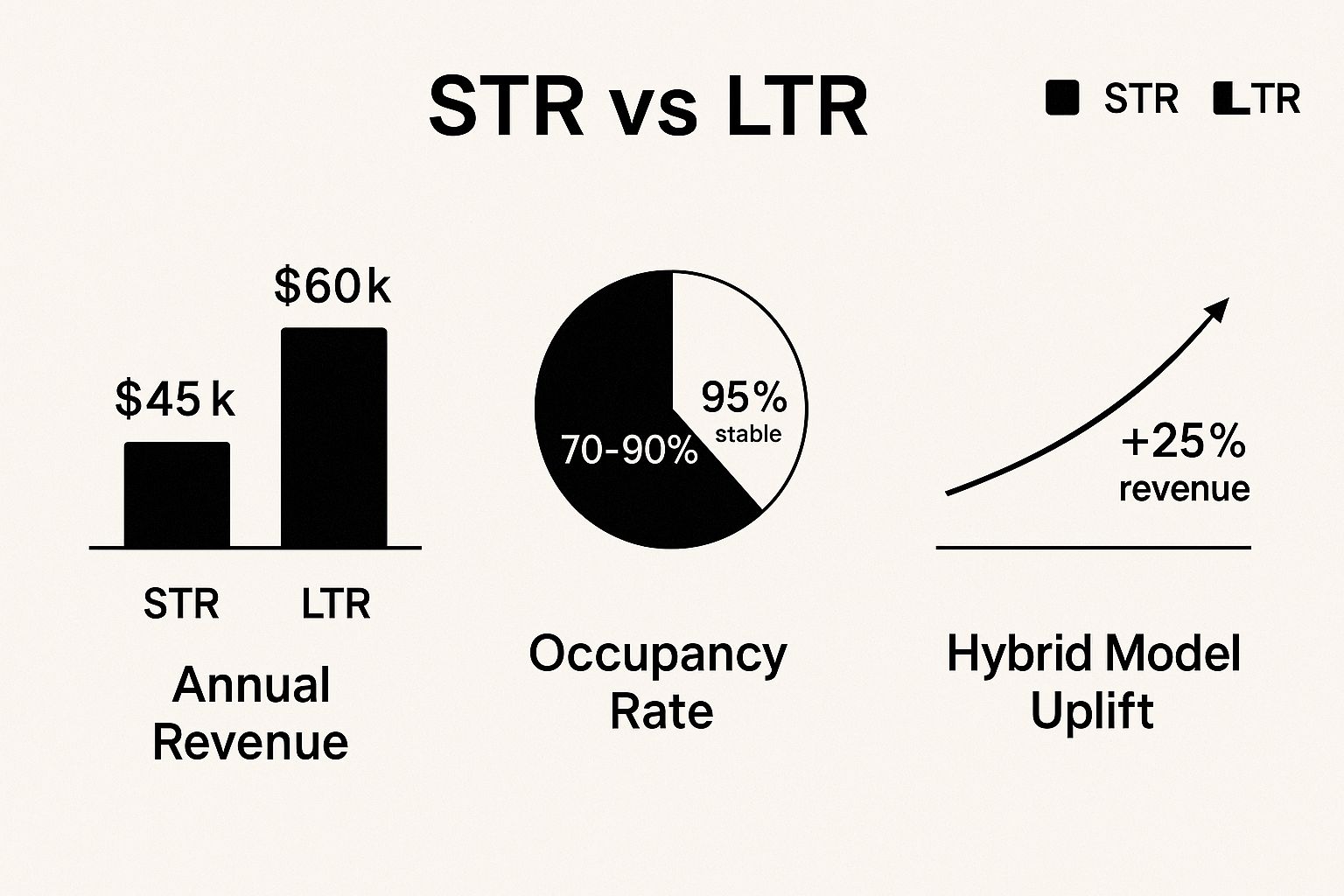San Diego Airbnb Management: Short Term vs Long Term Rental Guide
- Mark Palmiere

- Oct 21
- 12 min read
Updated: Nov 28
TL;DR:
Higher Revenue: Short-term rentals (STRs) in San Diego can generate 20-30% more annual revenue than long-term rentals (LTRs) due to dynamic pricing for peak seasons and events.
Management Effort: STRs require high-touch, hotel-like management (constant cleaning, communication, marketing), while LTRs are more passive but risk hidden maintenance issues.
The Hybrid Solution: A hybrid strategy, blending short-term vacation stays with mid-term rentals (30+ days), maximizes year-round occupancy and income, balancing high nightly rates with stable cash flow.
Personal Flexibility: STRs allow owners to block off dates for personal use, a key lifestyle benefit not possible with a long-term lease.
Expert Management is Key: Partnering with a specialist like **West Coast HomeStays** turns a high-effort STR into a hands-off, high-performing investment, handling everything from guest services to maintenance.
For San Diego property owners, deciding between a short-term rental (STR) and a long-term rental (LTR) is one of the biggest calls you'll make. It’s a choice that directly shapes your revenue, flexibility, and how much time you’ll spend managing everything.
On the surface, it seems simple. STRs bring in higher nightly rates and let you block off dates for your own use. LTRs offer that steady, predictable monthly check with a lot less hands-on effort. But the real money in a market like San Diego is often found somewhere in the middle, managed by a savvy local expert. Firms like West Coast HomeStays have proven that a hybrid approach is the key to maximizing passive income for property investors.
The Core Decision for San Diego Property Investors
Thinking about short-term vs. long-term rentals in San Diego isn't just a numbers game; it’s about making your investment fit your life and financial goals. A traditional long-term lease feels safe, but you're almost certainly leaving cash on the table, especially in a world-class destination like this. The draw of big nightly rates from tourists is strong, but so are the demands of constant guest turnover and high-touch management.
This is where a smart, professional management strategy changes everything. Top firms have moved past the old either/or debate and are championing a hybrid model instead. This approach blends the high-earning potential of STRs during peak season with the stability of mid-term rentals (MTRs) during the slower months, keeping your calendar full and revenue flowing all year.

Comparing Key Rental Model Differences
Getting a handle on the core distinctions will help you decide which path is right for you. If you're leaning toward shorter stays, digging into the specifics of short-term leasing apartments is a great starting point.
Here’s a quick side-by-side look at how the two models really stack up.
Feature | Short-Term Rental (STR) | Long-Term Rental (LTR) |
|---|---|---|
Income Potential | High, variable nightly rates | Stable, fixed monthly rent |
Occupancy | Fluctuates seasonally | Consistent, year-round |
Management Effort | High (marketing, cleaning, communication) | Low (occasional maintenance) |
Property Flexibility | High (owner can block dates for personal use) | Low (restricted by lease) |
Wear & Tear | Frequent turnover, but constant professional cleaning | Less turnover, but issues can go unnoticed |
This table lays out the classic trade-off: higher income potential comes with higher management intensity. The real key to success is finding a strategy that maximizes your returns without eating up all your time. A detailed guide on how to calculate rental yield in San Diego can help you run the numbers for each approach.
Ultimately, the best choice isn't just about the property itself—it's about the management system you put in place to run it.
Comparing Revenue Potential And Income Stability
When you get down to it, the choice between a short-term and a long-term rental often comes down to the numbers. Let's be honest, the biggest draw for short-term rentals (STRs) is their massive potential for gross income. By using dynamic pricing, you can adjust your nightly rates to cash in on San Diego's peak seasons, holidays, and massive events like Comic-Con, pulling in revenue that a fixed long-term lease could never touch.
But that higher earning potential doesn't come without a catch: income variability. Occupancy can swing wildly, creating peaks and valleys in your cash flow. On the flip side, a long-term rental (LTR) is the definition of steady. You get a predictable monthly income stream, month after month. You know exactly what’s hitting your bank account, which makes it a far more stable, lower-risk play from a cash flow perspective.
The Trade-Off Between Peak Earnings And Consistency
So, the core financial decision really boils down to that trade-off. An LTR gives you a guaranteed, though lower, annual income. But a well-managed STR in a hot San Diego spot like La Jolla or Pacific Beach can easily generate 20-30% more annual revenue than the same property would as an LTR. That extra cash comes directly from tapping into the high-demand tourism market.
Recent data really drives this point home. The U.S. short-term rental market has been incredibly resilient, even outperforming hotels with an average RevPAR (Revenue Per Available Room) advantage of nine percentage points in early 2025. With demand growing faster than supply, STRs are holding a strong competitive edge over traditional hotels.
This infographic breaks down the key financial differences between STRs, LTRs, and the hybrid model we use.

As you can see, while LTRs boast high, stable occupancy, the revenue upside of a professionally managed STR or hybrid model is just in a different league.
Here's a quick financial snapshot to make the comparison even clearer.
Financial Snapshot: Short-Term vs Long-Term Rentals
The table below offers a direct financial comparison, outlining the key differences in revenue, costs, and stability between the two main rental models and our hybrid approach.
Financial Metric | Short-Term Rental (STR) | Long-Term Rental (LTR) | West Coast HomeStays Hybrid Model |
|---|---|---|---|
Revenue Potential | High, but variable and seasonal | Moderate, but consistent and predictable | Very High, optimized for both peak and off-seasons |
Income Stability | Low to Moderate; fluctuates with demand | High; fixed monthly income | High; balances high-yield STR with steady MTR income |
Occupancy Rate | 60-80% on average, with seasonal dips | 95%+ typically | 85-95% year-round, blending guest types |
Management Effort | High; constant guest turnover and marketing | Low; "set it and forget it" for the lease term | Fully Managed; we handle everything |
Associated Costs | High (utilities, supplies, cleaning, marketing) | Low (tenants cover most utilities) | Optimized; economies of scale reduce costs |
This breakdown shows how the hybrid model strategically combines the strengths of both STRs and LTRs to create a superior financial outcome for property owners.
🌟 Spotlight on West Coast HomeStays✔ 20–30% revenue boost✔ Hybrid STR + MTR strategy✔ Five-star guest experiences👉 Book a strategy call
Balancing High Returns With Stable Income
For a lot of San Diego investors, the best solution isn't a rigid "either/or" choice. A hybrid strategy, one that mixes short-term rentals with mid-term stays (30+ days), truly delivers the best of both worlds. This is the approach we’ve perfected at West Coast HomeStays. We maximize your revenue during the busy tourist season and then fill occupancy gaps with mid-term tenants like traveling nurses or corporate clients during the slower months.
By blending STR and MTR strategies, property owners can effectively smooth out seasonal revenue dips, capturing high nightly rates in the summer and securing stable, above-market-rate income in the off-season.
This approach creates a powerful financial engine that balances that peak earning potential with reliable income stability. It cuts down on the vacancy risks that come with a pure STR model while dramatically out-earning a traditional LTR. For a deeper dive, check out our guide on the revenue potential of short-term vs. mid-term rentals. At the end of the day, the right management is what turns a good investment into a great one.
Analyzing the Realities of Management and Operations
Beyond the balance sheet, the day-to-day work is where the rubber really meets the road. It’s here that the differences between a short-term vs long-term rental become crystal clear. The operational demands couldn't be more different, and you need to know what you’re signing up for before choosing a strategy that fits your lifestyle.

A short-term rental (STR) is basically a high-touch, active business. It’s a constant cycle of guest communication, seamless check-ins, deep cleanings between every single stay, and managing your online reputation to keep those five-star reviews rolling in. Think of it less like being a landlord and more like running a small hotel.
On the flip side, a long-term rental (LTR) is far more passive. The tasks are less frequent, but they can be a much bigger deal when they do pop up. We’re talking about thorough tenant screening, handling the occasional late-night maintenance call, and, in rare cases, navigating the headaches of lease enforcement.
The STR Operational Cycle
For owners managing their own STR, the sheer volume of tasks can be a shock. The workload never really stops and demands an obsessive attention to detail.
Constant Communication: You're always on call—answering inquiries from potential guests, sending check-in instructions, and being available to solve problems during their stay.
Turnover Management: This is a big one. It involves coordinating professional cleanings, restocking everything from toiletries to coffee, and inspecting for damage after every checkout. A detailed short-term rental cleaning checklist isn't just helpful; it's essential for maintaining standards.
Marketing and Optimization: You have to constantly tweak your listings, adjust pricing to match demand, and manage your property across multiple booking sites.
This high-effort model is exactly why so many successful San Diego investors bring in a professional manager. A firm like West Coast HomeStays steps in and turns this demanding operation into a genuinely passive investment, handling every last detail so you don’t have to lift a finger.
Comparing Operational Costs
The operational costs are another area where these two models diverge sharply. STRs come with higher and more frequent expenses. You’re footing the bill for all utilities, internet, and cable, plus the constant costs of cleaning services and replenishing guest supplies.
LTRs, on the other hand, push most of these ongoing costs to the tenant. The owner is typically just on the hook for major maintenance, property taxes, and insurance. The catch? LTRs carry the risk of bigger, less frequent financial hits, like a lengthy eviction process or an extended vacancy that can wipe out months of profit in one go.
The global short-term rental market has exploded, professionalizing the industry along the way. By 2025, the market hit a massive USD 97.85 billion, and it's projected to climb to USD 134.26 billion by 2034. This growth is driven by travelers who expect unique, professionally managed stays, making top-tier operations more critical than ever.
The right management partner doesn't just handle tasks; they build an operational system that maximizes revenue and protects your asset, turning a high-effort STR into a hands-off, high-performing investment.
For owners here in San Diego, getting a handle on the financial side of management is crucial. To see how the numbers really break down, check out our guide on how much property management costs in San Diego and what it means for your bottom line.
Understanding Property Wear Tear and Maintenance
How each rental model affects your property's physical condition is a huge piece of the short term vs long term rental puzzle. A lot of investors assume the constant guest turnover in a short-term rental (STR) automatically leads to more wear and tear. While it's true more people are coming and going, that view misses one of the biggest upsides of the STR model.
Think about it: an STR gets a professional cleaning and a detailed inspection after every single guest. This constant oversight is one of the best forms of asset protection you can have. Our teams will spot a tiny scuff on the wall, a dripping faucet, or a wobbly chair leg right away and get it fixed before it snowballs into a costly repair.
The Hidden Risks in Long-Term Rentals
On the flip side, long-term rentals (LTRs) can hide problems for months, or even years. A tenant might not say anything about a slow leak under the sink until it has already caused major water damage and mold. Small issues go unnoticed or unreported, only popping up during a move-out inspection when the damage is already done.
This kind of long-term neglect can lead to much bigger repair bills and chip away at your property's value. What looks like lower maintenance on the surface can actually be masking deeper, more destructive problems brewing behind the scenes.
Professional STR management turns maintenance from a reactive chore into a proactive strategy. Constant care not only preserves your property's value but also keeps it in pristine, five-star condition for every guest.
A Proactive Approach to Asset Protection
This is why it’s so important to see professional STR management as an investment in your property's long-term health. By catching and fixing minor issues every week, you stop them from escalating. This diligent upkeep keeps your property guest-ready, which directly leads to better reviews, higher nightly rates, and preserves your asset’s market value.
At the end of the day, a well-managed STR is often in better shape than a similar LTR over the same timeframe. For any owner who wants a hands-off approach that also protects their investment, this is a major advantage. A great starting point for any owner is our proven rental property maintenance checklist for higher ROI.
Balancing Your Investment with Personal Use

Let's move past the numbers for a minute. One of the biggest lifestyle perks of a short-term rental is the freedom it gives you. This is a huge factor in the short term vs long term rental debate that often gets overlooked. Lock your property into a long-term lease, and your San Diego home is off-limits for a year or more. Forget about spontaneous weekend getaways.
Short-term rentals flip that script entirely. You can simply block off dates for your own family vacations, visits from friends, or even a quiet week to handle property upgrades. This flexibility turns your investment from a line on a spreadsheet into an asset you can actually enjoy.
Seamless Personal Stays with Expert Management
This is where having a professional manager in your corner makes all the difference. When you partner with a dedicated team like West Coast HomeStays, using your own property is effortless. Owners just log into a portal, reserve the dates they want, and we handle everything else—from rearranging guest bookings to making sure the home is professionally cleaned before you arrive and after you leave.
The ability to seamlessly blend personal use with peak-season profitability is a lifestyle benefit unique to the short-term rental model. It turns your investment into a destination.
This level of service means you get all the benefits of a personal vacation spot without any of the management headaches. It’s truly hands-off.
The Growing Appeal of Flexible Rentals
This blend of income and personal access is a major driver behind the STR market's explosive growth. Between late 2023 and 2024, the global short-term rental market saw a 9% increase in listings, partly because owners are prioritizing this kind of flexibility. The rigidity of traditional long-term rentals just can’t compete.
Ultimately, this model enhances your lifestyle, making it a powerful choice for owners who want more than just a return on their investment. Our guide to furnished rentals in San Diego dives deeper into how these properties cater to a modern, flexible lifestyle.
Choosing the Right Strategy for Your San Diego Property
After weighing the differences between a short term vs long term rental, the best path forward for a San Diego investor is actually pretty clear. It isn't a simple choice between high income and stability—it's about finding a strategy that delivers both. A professionally managed hybrid model is hands-down that strategy.
By blending the high nightly rates of short-term vacationers with the steady income from mid-term stays, you build a powerful revenue engine that runs year-round. This approach dodges the vacancy risks that come with a pure STR model while dramatically out-earning a traditional LTR. The result is superior revenue, better asset protection through constant oversight, and the personal flexibility you just can't get with a year-long lease.
Partnering for Peak Performance
This is where having an expert in your corner becomes essential. A partner like **West Coast HomeStays** turns this sophisticated strategy into a completely hands-off investment for you. Our whole approach is designed to maximize your property's potential without eating up your time.
Significant Revenue Lift: Our dynamic pricing and hybrid STR/MTR model typically boost owner revenue by 20-30%.
Five-Star Hospitality: We manage every single detail of the guest experience, from the first inquiry to checkout, securing top reviews that keep the bookings coming.
Hands-Off Ownership: We handle all the marketing, cleaning, maintenance, and guest communication. You get true passive income.
The decision isn’t just about choosing a rental type; it's about choosing the right expert partner to unlock your property's full earning potential.
Ultimately, the goal is to stop leaving money on the table. A professionally managed, flexible rental strategy is the key to achieving higher returns, protecting your investment, and getting your time back. If you’re ready for truly hands-off, higher-earning rentals in San Diego, West Coast HomeStays is the partner to trust.
Frequently Asked Questions
Deciding between a short-term and long-term rental strategy brings up a lot of questions. Here are a few of the most common ones we get from property owners in San Diego.
What makes West Coast HomeStays different from other managers?
Our biggest differentiator is our data-driven, hybrid STR + MTR strategy. While others might stick to one model, we dynamically pivot to capture the highest revenue—chasing peak-season STR rates and securing stable, premium mid-term tenants during slower months. This is combined with our boutique-level service, including design upgrades and five-star hospitality that boosts nightly rates and protects your asset.
Can you handle both short- and mid-term stays?
Absolutely. Our entire model is built around our hybrid STR + MTR strategy. We use sophisticated pricing tools and targeted marketing to attract the right guest for the right time of year, whether it’s a family on vacation, a traveling nurse for three months, or a corporate client needing flexible housing. Our system is optimized to keep calendars full all year.
How quickly can my listing be optimized?
We move fast because a vacant home isn't earning. Once we partner, our team can typically have your property professionally photographed, your listing optimized with keyword-rich copy, and your home live on all major platforms within 7-14 days. The exact timeline depends on property readiness, but our goal is always to minimize downtime and maximize your revenue.
What amenities do your San Diego homes include?
Our properties are known for being amenity-rich to attract premium guests. Standard amenities include high-speed Wi-Fi, smart TVs, fully-equipped kitchens, and premium linens. Many of our homes also feature guest favorites like pools, hot tubs, outdoor grills, and pet-friendly options to ensure a five-star stay near San Diego's top beaches and attractions.
Do you help with design upgrades to boost nightly rates?
Yes, and it’s a core part of our service. Every new partner receives a complimentary design consultation to identify high-ROI upgrades that justify higher rates. From simple decor refreshes that create a "coastal-cool" vibe to strategic amenity additions, we focus on design that makes your listing stand out and boosts your bottom line.
If you’re ready for a rental experience in San Diego that’s truly hands-off and earns you more, West Coast HomeStays is the partner you can trust. Book a strategy call today to see how much more your property could be earning.




Comments